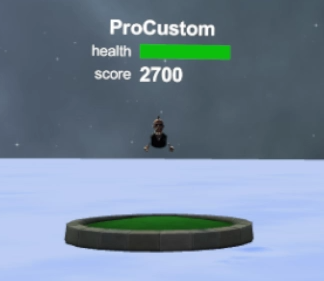Updated 30/09/20
Considering social anxiety in multiplayer VR games
An Oculus Start Game Jam

A recent game jam for Oculus Start members tasked us with considering how to use VR to overcome separation and foster connections. I immediately decided that a multiplayer game was required to help create bonds between players, but I had two issues. I had never created a multiplayer game before and I generally don't play them due to having social anxiety
Introverts are certainly drawn to computer games and many of them may feel excluded from multiplayer games while also being one of the groups that feel most isolated during the covid-19 pandemic. My direction was clear, I wanted to design a multiplayer game that considered introverts and people with social anxiety from the start. An experience for everyone where they could play with higher levels of comfort and maybe form bonds with players and then go on to play other VR games with them.
Starting in comfort
Feelings of anxiety develop quickly and dissipate very slowly. Choosing to enter a multiplayer game with strangers increases anxiety levels even before the game loads. It's therefore important to start the game in a safe space with maximum comfort levels and then let the user lower barriers between other players if and when they feel ready.
Personal space

I've had great experiences playing online with close friends and family and terrible ones where I've ventured out into the wider community. On entering one lobby I had three players inches from my face, all asking my name, if my microphone was on and whether I could hear them. I felt so uncomfortable that I had to quit and had no desire to return.
Having personal space is very important. Having a bubble around you that people can't enter is a good concept but just giving the user the option to erect that bubble when needed has numerous issues. The first being that if you are in a situation where you feel the need to activate it, your anxiety has already been elevated. The second being that it's an indication of your discomfort, which is something we don't want to broadcast.
In my game, players start (and remain) on their own separate platforms, 8m apart. That's not appropriate for all games, but an important starting point for my “anxiety-aware” game.
Overwhelming situations
One of the worst situations you can inflict on someone with social anxiety is a networking event. If we had the ability, you would see the person shaped whole in the wall as we left at super speed. Entering a noisy room full of chatting groups of people quickly induces a high level of anxiety. It doesn't matter how friendly the other people are because the worst thing you can do for us is to try and “bring us out of our shell” or totally wear us out by filling every potential silence with chatter. Numerous VR experiences feel like networking events to me.
For my game jam I allowed 2 to 4 players. Ideally the game would always include 4 players but I allowed 2 for easier testing and judging. Two players would feel too personal and carry the burden of communicating out of politeness, whereas four feels like you can leave other players to be social and fill the gaps.
Communication

Communication is turned off at the start of my game. Instead of voice-chat I start the game with a board of positive emojis that you can activate and move with each hand. Simple smiles and a thumbs-up allow you to convey messages of support and gratitude during the game while retaining a higher level of comfort. Additional benefits of alternative communication methods is that they bypass language barriers and support people with hearing difficulties.
To enable voice chat in my game you need to reach a certain level, giving the players time to bond, and then you can choose if you want to unlock voice chat (which I didn’t have time to implement during the jam). Optional voice-chat is obviously important, but it’s also helpful if a player that has disabled their mic can’t see if other people are talking, as that leads to a feeling of exclusion and pressure to enable their own mic.
Anonymity
My game starts with each player being anonymous which adds a level of comfort and helps to reduce anxiety. Initially I had the avatars all blue coloured to increase the anonymity, but I had to temporarily remove that due to timescales and a bug on the remote avatars. My goal was to remove all identity so that the team bonded during play without knowing anything about each other's race, gender or age. After reaching a certain level, if the player feels comfortable, they can press a button to reveal their identity and Oculus avatar. I made that button always available during the jam for testing purposes.
I would now also add the feature that if you didn't reveal your identity, then you wouldn't see the other player's identity either. This means that you are not aware if the other players have revealed their identity and feel no pressure to follow suit.
Equality
People with anxiety don't want to draw attention to ourselves. Putting us in a large bubble or highlighting that our mic is disabled makes us stand out. We just want to blend into the room and be a part of the group, like everyone else in the game. This is why everyone in my game starts off with communication disabled and being anonymous. If it was optional from the start, it wouldn't work.
It's also important to start the game with a simple idea and slowly develop the gameplay so that people feel they understand what is required rather than the game being instantly dominated by more experienced players. My game is therefore very simple. If I took it further it would introduce new concepts as the levels progressed, but slowly and clearly.
Being part of a team
Those with social anxiety know that team building exercises were obviously created in hell as a form of torture, but here I am creating a team game that aims to build bonds. I tried to work around this with the gameplay concept.
In the game you simply have to shoot bombs that are heading towards all 4 players. Rather than compete against each other, I wanted to encourage bonding by having to look after each other. To do this I gave the bombs shields that block the lasers from the player they are attacking. This means that you are responsible for saving your teammates while they are responsible for saving you, like an ongoing trust exercise. At the end of the round everyone inherits the lowest player's score and health, so if they didn't look after you they suffer the consequences.
Similarly the second round-type allows you to fire a healing shot at your teammates. You have a limited amount of power and health needs to be shared equally because you will all receive the lowest player's health at the end of the round. Again this makes players include everyone equally.
Having 4 players (the intended number) means that it's difficult to point the finger and say who is responsible for letting another player get hit. You share the effort and results as a team, you earn a team score and if one fails you all fail. If I develop the game further, the new level types would all follow this core concept of shared, but obscure responsibility. This is an important concept because it also helps remove negative feelings.
Matchmaking
My game doesn't support friend invites. You join a random room with anonymous strangers and everyone is in the same position. Maybe you will reveal your identity and discover that you have been playing with a friend all along. This is to avoid the situation where some players feel excluded due to playing with other people that are obviously friends and primarily look after each other.
I would also add matchmaking rules that include ability metrics to group more experienced players.
Ideally games would offer rooms that suited different personality types so that they had the opportunity to play with people of a similar nature.
Social anxiety and VR
I've always been an introvert, but when I left my office job and became self-employed my anxiety levels grew. One day I was expecting a delivery and realised how severe my stress was, just because I needed to answer the door. I knew that wasn't right or healthy. After minutes searching the Internet I learned about social anxiety. Realising how common social anxiety was brought me some immediate comfort. After reading up on Cognitive Behavioural Therapy (CBT) I soon made improvements and better understood my own mind. By avoiding social interactions, I had actually been increasing my anxiety. VR has the potential to improve the lives of people with social anxiety by increasing their social interactions in a controlled and comfortable way and providing them with a way to form new bonds.
I still only play online with family and close friends because the VR experiences out there, that I have tried, are not comfortable for me. Special consideration needs to be given to comfort levels and game types that are more inclusive by design.
I would also love to play online games that had roles designed for different personality types, all playing together, while bringing the best out of us all.
Closing thoughts
I'm not suggesting that every game should cater for people with social anxiety, but recognise that these traits are in a large number of players to a lesser extent, so some consideration could result in multiplayer games being enjoyed more regularly by a wider audience.








